Individuals with sickle cell anemia (SCA) often have kidney damage. Approximately 25% of infants exhibit hyposthenuria, 10-30% of adolescents progress to albuminuria, and up to 20% of adults have albuminuria and progressive renal insufficiency, defined as a creatinine clearance of <90 mL/min, or chronic kidney disease (CKD).1 Individuals with SCA and CKD frequently progress to end stage renal disease (ESRD) and require dialysis or transplant; however, individuals with SCA have a worse survival and are less likely to receive a kidney transplant compared to African Americans with ESRD who do not have SCA.2,3 One approach to improve clinical outcomes for individuals with SCA is to identify those at high risk of developing ESRD and initiate renoprotective medical therapies early; these include angiotensin-converting-enzyme (ACE) therapy which is beneficial for individuals with and without SCA,4,5 and hydroxyurea (HU) which is beneficial for individuals with SCA who have advanced renal damage.6,7
Albuminuria is an accurate early marker of renal damage,2 and the National Heart Lung and Blood Institute (NHLBI) guidelines for SCA recommend screening for albuminuria beginning at ten years of age for all patients; however, genetic information may allow earlier identification of those at risk for ESRD and thereby influence therapeutic decisions. There are two common variants in the apolipoprotein L-1 (APOL1) gene that confer increased risk for kidney disease in a variety of clinical circumstances and accelerate kidney damage synergistically with numerous other comorbid medical conditions.8–13 Variant G1 is comprised of two strongly linked missense mutations: rs73885319 (p.S342G) and rs60910145 (p.I384M). Variant G2 is a 6 base pair (bp) in-frame deletion (rs71785313, N388del:Y389del). These variants are enriched in African populations due to evolutionary selective pressure for resistance to trypanosomiasis,8,9 similar to the enrichment of sickle cell disease (SS) due to resistance to malaria, and cross-sectional studies of SCA cohorts have associated APOL1 risk alleles with albuminuria.10,14,15 However, the effects of these APOL1 variants on the age of onset of albuminuria and the rate of progression to CKD over time are not known. Understanding how genetic risk factors influence the progression of SCA-associated kidney disease is essential for identifying individuals who would benefit most from early therapeutic intervention.
The Sickle Cell Clinical Research and Intervention Program (SCCRIP; clinicaltrials.gov identifier: 02098863)16 is a lifetime longitudinal study that assesses organ function and couples that phenotypic information with whole genome sequencing (WGS). We tested the hypothesis that APOL1 G1 and G2 variant alleles confer an increased risk for kidney damage, evidenced by albuminuria, in young children with SCA followed longitudinally from birth in the SCCRIP cohort.
We analyzed WGS data by aligning paired-end 150 bp reads to the GRCh38 human reference using the Burrows-Wheeler Aligner (BWA-ALN v0.7.12) to achieve 30x average coverage. Genetic variants in all patients were then determined by the GATK best-practices work-flow (GATK v3.4.0), and APOL1 G1 (rs73885319/rs6090145) and G2 (rs71785313) variants were extracted. In addition to testing each APOL1 variant individually, we also considered a model in which we defined high-risk APOL1 mutations as either APOL1 G1 or G2 homozygotes, or G1/G2 double heterozygotes. We used matched case-control analysis to associate APOL1 variants with albuminuria versus controls using conditional logistic regression models matched by sex, age, and HBB genotype. Further, time-to-albuminuria analyses, defined by urine albumin:creatinine ratio (ACR) >30mg/g, were conducted using the Weibull parametric survival regression model accommodating left, right, and interval censored data. Participants were censored at 13 years old for the time-to-event analysis due to sparse date. Survival analyses were adjusted for time spent on HU therapy. All statistical analyses were performed using SAS V9.4. (Cary, NC, USA) and R-3.2.5.
We analyzed 291 participants with SCA (n= 272 HbSS, 19 HbSβ0 thalassemia) for APOL1 risk variants and ACR. The mean age at the time of the most recent urine ACR measurement was 11.5±4.76 years old. Among 175 participants ≥10 years, 22% of participants developed albuminuria; all had HbSS genotype.
We performed a 1:1 matched case-control analyses of patients with and without albuminuria, controlling for sex, age, β-globin genotype, and “ever”/“never” on HU. Consistent with previous findings, homozygosity for either G1 or G2 or compound G1/G2 heterozygosity were associated with albuminuria (P= 0.0217) (Table 1). In contrast, we have not yet identified an association between α-thalassemia genotypes on the development of albuminuria in this young cohort (HR = 0.723, 95%CI: 0.406 -1.289; P=0.2713). Next, to test the impact of APOL1 high-risk variants on time to develop albuminuria, we performed survival analysis. Multivariate survival analyses showed that the time to develop first albuminuria was shortened by 41% [event time ratio estimate, 0.59; 95% Confidence Interval (CI): 0.44-0.79] for individuals with high-risk APOL1 variant combinations (P=3×10−4) (Figure 1). Also, every one year increment in time spent on HU treatment (P=0.01)16 was correlated with a 7% (event:time ratio estimate, 1.07; 95%CI: 1.01-1.13) delay in time to first albuminuria. Double heterozygotes had an event:time ratio estimate of 0.74 (95%CI: 0.51-1.07; P=0.11) after adjusting for time on HU treatment (data not shown).
Table 1.
Characteristics of patients and genetic association results for APOL1 variants with albuminuria.
Figure 1.
Time to first albuminuria in patients with and without APOL1 risk variants. Kaplan-Meier curve showing shorter time to albuminuria diagnosis for individuals homozygous for APOL1 G1 or G2 or double heterozygous for G1/G2. APOL1 G1 homozygotes defined as rs73885319=″GG″/rs6090145=″GG″. APOL1 G2 homozygotes defined as rs71785313=″−/−″. APOL1 G1/G2 double heterozygotes defined as G1/G2 (both heterozygotes). Albuminuria defined by first visit with microalbumin creatinine ratio (MCR) ≥30. Analyses adjusted for total HU up to time of albuminuria diagnosis or at time patient was censored. Patients with sickle cell (SS) disease and Sβ0 included in analyses.
Prior studies showed that APOL1 risk alleles confer increased risk for albuminuria in older individuals with SCA, which heralds future CKD.7,10,12 Our data provide novel evidence that APOL1 risk alleles predict earlier onset of albuminuria in young children, even prior to the recommended screening timelines from current guidelines. In contrast, α-thalassemia, which has been shown to be protective against the development of albuminuria in adults with SS, has not yet been identified as a significant risk factor for the development of albuminuria in this younger cohort. Thus, APOL1 screening of children with SS is likely to identify those at high risk for development of albuminuria and those at risk of developing early CKD. These individuals may benefit from HU or renoprotective therapies prior to the onset of albuminuria, when glomerular damage has already begun.
Limitations of this study include the young age of the cohort, relatively small sample size, and short follow-up time. These limitations reduced our ability to assess other risk variables including concomitant therapies, total hemoglobin level, fetal hemoglobin fraction and hypertension, or to examine the impact of G1 versus G2 separately on the development of albuminuria. While these data show the association of APOL1 with albuminuria, it will be important to evaluate the association of APOL1 variants with a decline in eGFR in this and other adult cohorts. Finally, our time-to-event analysis was based on the development of a first episode albuminuria.
In summary, we have shown that the onset of glomerular injury leading to albuminuria occurs earlier than ten years of age in participants with APOL1 risk alleles, and we suggest that children with SCA should be screened for APOL1 variants to apply the principles of precision medicine by identifying a high-risk population that may benefit from earlier screening for renal damage and potentially to initiate renoprotective therapies. In the future, we aim to track participants into adulthood to assess how APOL1 risk alleles and other modifiers influence the progression from albuminuria to CKD to ESRD.
Acknowledgments
The authors thank the families and children with SCD who participated in SCRIPP.
Footnotes
Information on authorship, contributions, and financial & other disclosures was provided by the authors and is available with the online version of this article at www.haematologica.org.
References
- 1.McPherson Yee M, Jabbar SF, Osunkwo I, et al. Chronic kidney disease and albuminuria in children with sickle cell disease. Clin J Am Soc Nephrol. 2011;6(11):2628–2633. [DOI] [PMC free article] [PubMed] [Google Scholar]
- 2.Guasch A, Navarrete J, Nass K, Zayas CF. Glomerular involvement in adults with sickle cell hemoglobinopathies: Prevalence and clinical correlates of progressive renal failure. J Am Soc Nephrol. 2006;17(8):2228–2235. [DOI] [PubMed] [Google Scholar]
- 3.Nielsen L, Canoui-Poitrine F, Jais JP, et al. Morbidity and mortality of sickle cell disease patients starting intermittent haemodialysis: a comparative cohort study with non- Sickle dialysis patients. Br J Haematol. 2016;174(1):148–152. [DOI] [PubMed] [Google Scholar]
- 4.Haymann JP, Hammoundi N, Stojanovic S, et al. Renin-angiotensin system blockade promotes a cardio-renal protection in albuminuric homozygous sickle cell patients. Br J Haematol. 2017;179(5):820–828. [DOI] [PubMed] [Google Scholar]
- 5.Hou FF, Zhang X, Zhang GH, et al. Efficacy and safety of benazepril for advanced chronic renal insufficiency. N Engl J Med. 2006;354(2):131–140. [DOI] [PubMed] [Google Scholar]
- 6.Zahr RS, Hankins JS, Kang G, et al. Hydroxyurea prevents onset and progression of albuminuria in children with sickle cell anemia. Am J Hematol. 2018;94(1):E27–E29. [DOI] [PMC free article] [PubMed] [Google Scholar]
- 7.Bartolucci P, Habibi A, Stehle T, et al. Six Months of Hydroxyurea Reduces Albuminuria in Patients with Sickle Cell Disease. J Am Soc Nephrol. 2016;27(6):1847–1853. [DOI] [PMC free article] [PubMed] [Google Scholar]
- 8.Parsa A, Kao WH, Xie D, et al. APOL1 risk variants, race, and progression of chronic kidney disease. N Engl J Med. 2013;369(23):2183–2196. [DOI] [PMC free article] [PubMed] [Google Scholar]
- 9.Kopp JB, Nelson GW, Sampath K, et al. APOL1 genetic variants in focal segmental glomerulosclerosis and HIV-associated nephropathy. J Am Soc Nephrol. 2011;22(11):2129–2137. [DOI] [PMC free article] [PubMed] [Google Scholar]
- 10.Ashley-Koch AE, Okocha EC, Garrett ME, et al. MYH9 and APOL1 are both associated with sickle cell disease nephropathy. Br J Haematol. 2011;155(3):386–394. [DOI] [PMC free article] [PubMed] [Google Scholar]
- 11.Peralta CA, Bibbins-Domingo K, Vittinghoff E, et al. APOL1 Genotype and Race Differences in Incident Albuminuria and Renal Function Decline. J Am Soc Nephrol. 2016;27(3):887–893. [DOI] [PMC free article] [PubMed] [Google Scholar]
- 12.Kasembeli AN, Duarte R, Ramsay M, et al. APOL1 Risk Variants Are Strongly Associated with HIV-Associated Nephropathy in Black South Africans. J Am Soc Nephrol. 2015;26(11):2882–2890. [DOI] [PMC free article] [PubMed] [Google Scholar]
- 13.Larsen CP, Beggs ML, Saeed M, Walker PD. Apolipoprotein L1 risk variants associate with systemic lupus erythematosus-associated collapsing glomerulopathy. J Am Soc Nephrol. 2013;24(5):722–725. [DOI] [PMC free article] [PubMed] [Google Scholar]
- 14.Saraf SL, Shah BN, Zhang X, et al. APOL1, alpha-thalassemia, and BCL11A variants as a genetic risk profile for progression of chronic kidney disease in sickle cell anemia. Haematologica. 2017;102(1):e1–e6. [DOI] [PMC free article] [PubMed] [Google Scholar]
- 15.Kormann R, Jannot AS, Narjoz C, et al. Roles of APOL1 G1 and G2 variants in sickle cell disease patients: kidney is the main target. Br J Haematol. 2017;179(2):323–335. [DOI] [PubMed] [Google Scholar]
- 16.Hankins JS, Estepp JH, Hodges JR, et al. Sickle Cell Clinical Research and Intervention Program (SCCRIP): A lifespan cohort study for sickle cell disease progression from the pediatric stage into adulthood. Pediatr Blood Cancer. 2018;65(9):e27228. [DOI] [PubMed] [Google Scholar]




